#Colin Clive as Dr. Frankenstein
Explore tagged Tumblr posts
Text
Anyone else have an unhealthy soft spot for unstable/semi-insane (sometimes it’s not an ‘or’ but an ‘and’), morally questionable (sometimes at best), and emotionally unavailable, fictional men? Or did your parents love you?
edit: if anyone has suggestions for more movies like the ones in the tags I’d love to hear them
#Sleepy thoughts#Peter Cushing as Dr. Stein#the revenge of frankenstein#Vincent price in… pretty much anything he was in#Colin Clive as Dr. Frankenstein#This one ranks sort of low on the list of questionability but also Basil Rathbone as Sherlock Holmes#I’m sure the list goes on#I’ll go away now
3 notes
·
View notes
Text

Happy Birthday to Colin Clive! The amazing Dr Frankenstein! These brand new Frankenstein art prints are now available in the shop! www.bwanadevilart.bigcartel.com
#bwanadevilart#art#illustration#horrorart#lowbrowart#prints#fanart#painting#artists on tumblr#spooky#classic horror#horror artist#frankenstein#dr frankenstein#colin clive#movie art
13 notes
·
View notes
Photo
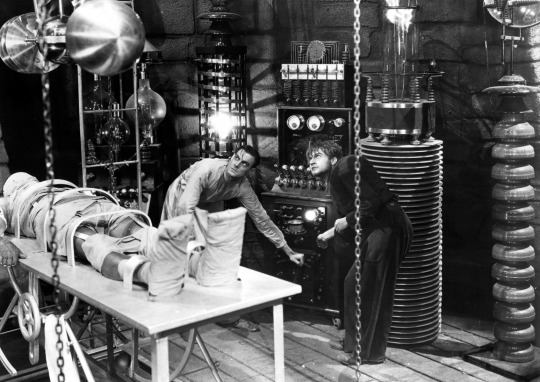
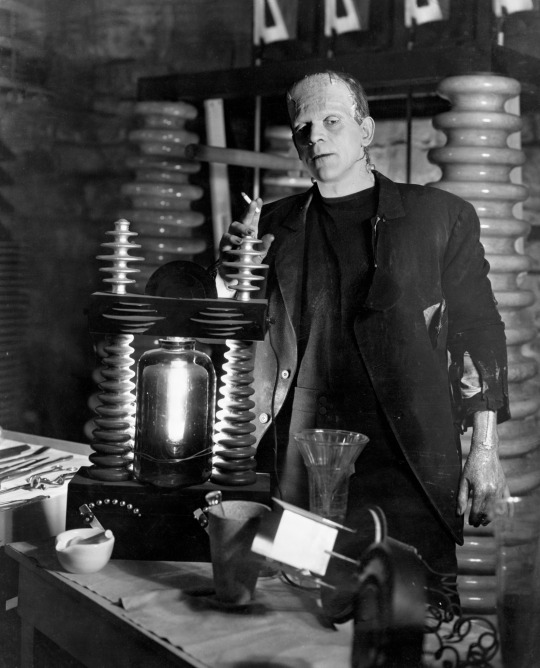
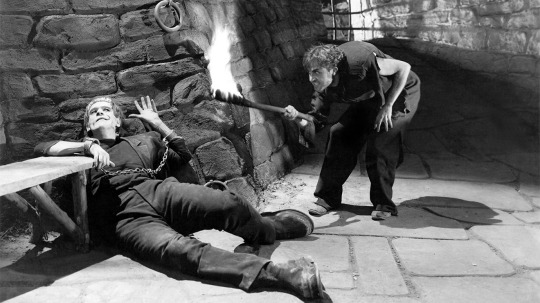
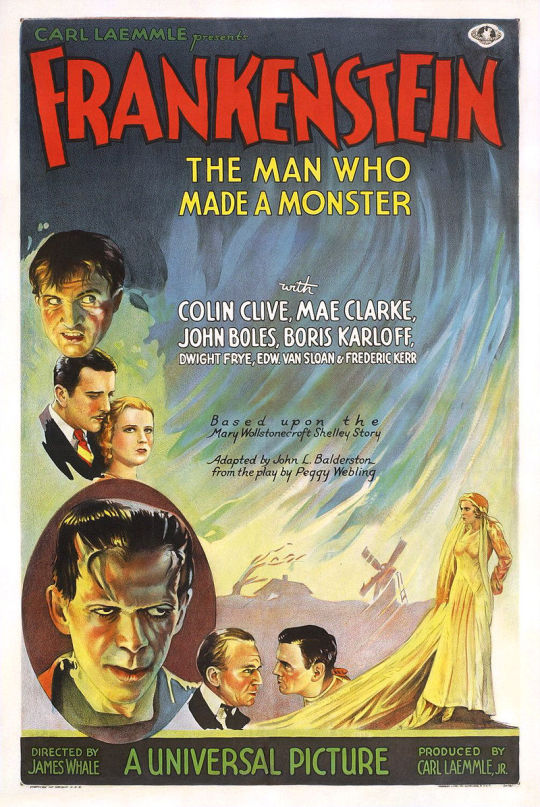
Frankenstein 1931
William Pratt (Boris Karloff)
#Frankenstein#William Pratt (Boris Karloff)#cine de culto#terrified#Terror y misterio#cine clasico#cigarros pall mall#Ron Cartavio#Hot Topic#vans classics#vans old school#cerveza Pilsen#cervezas y chicas#pizzas y musica#dr martens#Boris Karloff#Colin Clive#Victor Frankenstein#Mae Clarke#elizabeth lavenza#Edward van Sloan#Doctor Walkman
3 notes
·
View notes
Text

0 notes
Text
"It is interesting to think, Henry ...that once upon a time, we would have been burnt at the stake as wizARDS, for this experiment"...Dr Pretorius to Henry Frankenstein; The Bride of Frankenstein 1935

Ernest Thesiger and Colin Clive in The Bride of Frankenstein (1935)
#Dr Pretorius#Ernest Thesiger#The Bride Of Frankenstein#Colin Clive#Henry Frankenstein#Universal horror
355 notes
·
View notes
Text

"The bride of Frankenstein"
On stage we saw Boris Karloff, Elsa Lanchester, Colin Clive, Valerie Hobson i Ernest Thesiger. The film is a continuation of the 1931 film titled "Frankenstein" in which most of the same actors appeared.
The film is not one of my favorites, but it is important in cinematography. Elsa's appearance in the film has become iconic for creators of comics and fairy tales. "The Bride of Frankenstein" is finally another one of Universal's unique and important monsters.
In the first scene of the film we can see Mary Shelley who, encouraged by her friend, begins to tell the sequel to her book.
of course, this part of the Frankenstein story also had a sequel titled "The Son of Frankenstein", in which Béla Lugosi appeared.
Dwight Frye appeared in the film, who in the first part, in which he played Fritz, died after being murdered by Frankenstein, but in Frankenstein's Bride, he played Karl, who was also killed by the monster. I don't think Dwight gets a happy ending in any movie.
The same people worked on the film as on the first part.
"The Bride of Frankenstein" was included in Time magazine's list of the 100 greatest films in history in 2005.
It is also interesting that Colin Clive, the film's Doctor Frankenstein, had a broken leg during the filming, which forced him to sit in most of the scenes in the film. this is called sacrifice.
The scene where Karl kills his aunt and uncle in a monster style was deleted from the film.
time for a summary.
The monster created by Dr. Frankenstein survives the mill disaster that took place in the movie Frankenstein. Meanwhile, its creator leads a quiet life with his beloved wife, Elizabeth. He does not know that at the same time another scientist, Dr. Pretorius, is conducting experiments on reviving human corpses. He wants to create a woman who will be a partner for the monster.
Worth watching (wait for the entry about nosfertu, I will be refreshing my film today, so I will write an entry soon).





#actor#movie#movies#old movies#horror#dwight frye#colin clive#elsa lanchester#boris karloff#valerie hobson#frankenstein 1931#mary shelly's frankenstein#mary shelley#the bride of frankenstein#1930s#old cinema#old hollywood#horror books#books
24 notes
·
View notes
Text

Ah, Waxwork II: Lost in Time! Or as I like to call it, Bill and Ted's Army of Darkness!
In case you missed my recap of the first Waxwork film, this is a duology of horror comedies characterized by three things: classic horror homages, sexual perversity, and the repeated humiliation of Mark the protagonist. The sequel doesn't hang together quite as well, but I think it's interesting nonetheless, in that the worldbuilding gets weirder with every scene, and my hypothetical novelization in which I try to work it out grows in increasingly epic proportion.
Ready to see more of Mark not getting laid? Read on!
We open with a quick flash of images from the end of the first film, not that it really matters- the whole waxwork conceit is over now, despite the title. Things are off to a weird start, since Sarah has not only been recast, the new actress isn't even styled the same- they have the same ending scene, but now there's a girl who looks like Kim Basinger in LA Confidential. It's similar to what they did with Jodie Foster and then Julianne Moore as Clarice Starling, but Foster declined that sequel because she was offended by the original ending, whereas here I guess they wanted as many actresses to not sleep with Mark as possible.
The theme music in this film sounds like a legally distinct version of the song from Suspiria. I thought I should mention that.
Unfortunately, a severed zombie hand also survived the last movie. It follows Sarah home, where she is threatened with an abusive stepfather who was never mentioned before. He is angry that she's sneaking home after being out late, which begs the question of how she got away with partying with China in the last film. Maybe China always drugged the stepfather and now that she's dead, there's nobody with access to narcotics? Anyway, he dies pretty much as soon as he's introduced, courtesy of the severed zombie hand. Sarah disposes of it in the sink garbage disposal, but that leaves her covered in gore beside her dead stepfather.
The next scene we see of her is at a murder trial. (I think? More on that in a bit.)
Sarah's legal case that a severed zombie hand killed her stepfather isn't going over well in court, although to paraphrase Legal Eagle, once your lawyer enters a plea of "not guilty because monsters are real", the judge should probably declare a mistrial. We also learn that over 200 people were found dead when the Waxwork burned down, which really doesn't square with the crowd we actually saw there. It was a big mob fight scene, but it did not look like over 200 people.
Strangely, after the court arguments, Sarah gets into a cab with Mark to try and go prove her innocence. Can you do that if you're on trial for murder? I don't think you can do that. Maybe this wasn't actually the trial, but a grand jury or an inquest or something? Anyway, they go back to the home of the occult professor guy from the last movie, and find some more of the monster hunting artifacts he and his colleagues collected- including a bloody Jason mask. Maybe this is in the universe where Peter Cushing accepted the role of Dr. Loomis when he was offered it, then proceeded to just kill all the available slashers?
Before he died, Sir Wilfred (the professor guy) recorded information about traveling to other times and places via "going through the looking glass." Sarah has read Alice in Wonderland, which is lucky because Mark can't even put together that "looking glass" means "mirror" without her help. He has gotten significantly dopier since the last movie. The key to opening the portal to other times turns out to be a chess set with Alice in Wonderland pieces, so off they go to find a new disembodied hand to prove to the jury that such things are possible.
If I were Sarah I would probably just say "fuck it" and find a new world to live in.
The first horror movie- I mean, time and place- they land in seems to be the Universal Frankenstein movie, but with Udo Kier instead of Colin Clive. Mark takes the role of Henry Clerval remembers who he is in the future, while Sarah takes the role of Elizabeth Frankenstein and does not. Unfortunately, the bad doctor sees his friend making eyes at his wife, and has his cackling hunchbacked assistant throw him to the monster to kill. I love it whenever Frankenstein is portrayed as a bit crazy over Elizabeth, so I appreciate it here. (I loved The Dark Descent of Elizabeth Frankenstein, and I will even defend it.)
Mark gets on the monster's good side by finding him food, but only after suggesting they "order a pizza." Mark seemed reasonably put together in the first movie, but here he is not the brightest jack o lantern on the street.
Even in the face of an angry mob, Frankenstein rails and attacks his romantic rival. It's bad enough that he found Elizabeth talking in private with another man, he says, but with that dork Henry? Mark is sad to be spoken of this way, but he's used to it by now.
Mark's previous kindness to the monster pays off, and he and Sarah head off to find other portals while Frankenstein gets throttled (in good Frankenstein tradition.) They get separated in the ether, however, off to different places and scenes. These scenes cut back and forth between each other, but for the sake of convenience, I will discuss them separately in their entirety.
The theme song in the Frankenstein sequence sounded like a legally distinct version of the song from Young Frankenstein. I thought I should mention that.
Mark finds himself in The Haunting of Hill House- or rather, the 1963 film The Haunting. (Do horror kids today still watch The Haunting? They should.) Further cementing any associations with Army of Darkness, Bruce Campbell himself, in tweeds and with a pipe, leads a crew of paranormal investigators in black and white footage; Mark is his friend in a bad blonde wig, and Sarah is now the mousy Eleanor, whose main function is to constantly be hit on by Theo. Which I guess puts it one up on the Netflix adaptation. We get the classic scares from the 1963 film, with mysterious pounding and bulging at the door and voices calling Eleanor to come home, but Eleanor escapes her dark fate in this timeline. The others, though, fare worse.
Theo is hanged and then possessed by a ghost, but that's a kindness compared to what happens to Bruce Campbell. We find him at the climax of the sequence chained up, flayed open to his ribcage, with an eagle pecking out his organs. He then gets knocked face down on the ground, knocked in the head repeatedly with various objects, and has his wounds comically doused in salt and vinegar. He keeps up a cheerful, vaguely condescending fifties dad attitude nevertheless.
This sequence is what makes the entire movie for me, and it's kind of a shame when it ends with an exorcism.
Sarah, meanwhile, is in Alien, as the captain of a salvaging space crew with a xenomorphic hitchhiker. The men on board get into a comically macho yelling match, but it doesn't save them when the alien attacks. I make fun of these films, but despite being cheap B-movies, they make the most of their limited budget and give us some good, pragmatic practical effects setpieces. Sarah blows the alien out of the airlock, then meets Mark again, who tells her about various adventures he went on that we didn't see. I'm not sure if this is a joke or if those scenes were cut.
When Mark and Sarah proceed to their next portal-hopping rest stop, they change genre a bit- instead of doing a horror pastiche, they do a pastiche of shlocky 80s fantasy movies. I love shlocky 80s fantasy movies, but this part of the movie lasts a weirdly long time for something that's supposed to be a horror comedy. They have an actual character moment where they talk about how Sarah wants to go back and show the jury the truth about the zombie hand because she feels guilty about their friends dying in the last movie. Those friends will never be mentioned again.
Sarah is carried off by evil knightly henchmen, and the mullet and jerkin-clad Mark is left on his own- all except for a mysterious man who I think is doing a David Carradine impression. He tells Mark that an evil overlord called The Master abducts and torments the women he desires, including his own lost love Lenore. To avenge her and save Sarah, he gives him some kind of magic sword and vanishes into thin air. Great.
Like I said, this part of the movie lasts a long time, so I'll try to be concise here. ("No, there is too much- let me sum up.") The Master is a perverted dark magician overlord who wants to usurp the King of England, despite this not looking like a world that would have an England. He has a creepy henchman who evokes what I call the Fancy Sadist Problem, but that's its own long post. Sarah is the sister whom The Master incestuously desires, and Mark has to be helped out of humiliating captivity by the ghost of Sir Wilfred. This ghost tells him that he has been playing in "god's Nintendo game", time hopping to keep fighting evil in different universes. I think. I'm not entirely sure how it works. It sounds a bit like Michael Moorcock's Eternal Champion mythos. I would expand upon it in my novelization.
The second best scene in the movie happens when Mark fences with the Master, and they crash through the portal to keep fencing though the street of various other horror movies- Jekyll and Hyde, Dawn of the Dead, Godzilla, Nosferatu, I think Invasion of the Body Snatchers, and something with Jack the Ripper. Whom they defeated along with the other evil souls in the first Waxwork movie, but time and space and alternate universes, etc. Hyde does the "How much of this bottle did I drink?" gag, which was very funny when done with a boiling beaker.
Mark and Sarah manage to snag a hand in Dawn of the Dead, but only she can go back through the portal because Wilfred's ghost says she needs to sort through her own problems before she can be a time warrior. I wish this was the first movie so that that meant accepting her masochism and finding healthy BDSM partners, but no, it means showing the severed hand to the jury.
Mark tells Sarah that he loves her when she leaves through the portal, but she doesn't hear him. Story of Mark's life. At least he manages to send her a letter via a postman who delivers letters centuries after they were first postmarked. And that postman's name, I assume, was Moist von Lipwig.
Even once Sarah is exonerated and goes off to be a time warrior with him in the final few minutes, though, she never requites his affections. Maybe we can assume she will, and she clearly cares about him deeply, but she never says she loves or even likes him, and they don't have what would seem to be the obligatory ending kiss.
Throughout time and space and alternate universe, the only thing that remains constant is Mark not getting laid.
10 notes
·
View notes
Text
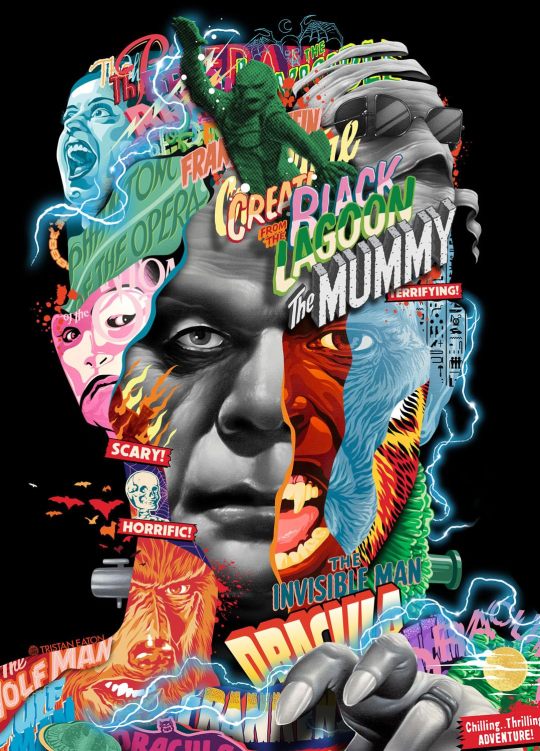
The Universal Classic Monsters Collection will be released on 4K Ultra HD (with Digital) in digibook packaging on October 3 via Universal. Designed by Tristan Eaton, the eight-disc set is limited to 5,500.
It includes 1931's Dracula, 1931’s Frankenstein, 1932’s The Mummy, 1933’s The Invisible Man, 1935’s The Bride of Frankenstein, 1941’s The Wolf Man, 1943’s Phantom of the Opera, and 1954’s Creature from the Black Lagoon.
All eight films are presented in 4K with HDR10. The Spanish version of Dracula is also included. Special features are listed below, where you can also see more of the packaging.
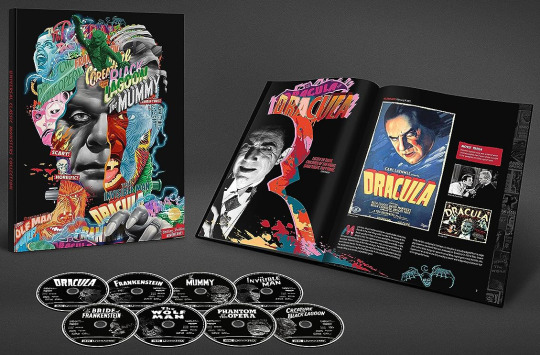
Dracula is directed by Tod Browning (Freaks) and written by Garrett Fort (Frankenstein), based on Bram Stoker’s 1897 novel. Bela Lugosi, David Manners, Helen Chandler, Dwight Frye, and Edward Van Sloan star.
Dracula special features:
Alternate score version by Philip Glass
Dracula (1931) Spanish version directed by George Melford
The Road to Dracula
Lugosi: The Dark Prince
Dracula: The Restoration
Dracula Archives
Monster Tracks
Trailer gallery
Transylvanian vampire Count Dracula bends a naive real estate agent to his will, then takes up residence at a London estate where he sleeps in his coffin by day and searches for potential victims by night.
Frankenstein is directed by James Whale (The Indivisible Man) and written by Garrett Fort (Dracula) and Francis Edward Faragoh (Little Caesar), based on Mary Shelley’s 1818 novel. Colin Clive, Mae Clarke, John Boles, and Boris Karloff star.
Frankenstein special features:
Audio commentary by film historian Rudy Behlmer
Audio commentary by historian Sir Christopher Frayling
The Frankenstein Files: How Hollywood Made A Monster
Karloff: The Gentle Monster
Universal Horror
Frankenstein Archives
Boo!: A Short Film
100 Years of Universal: Restoring the Classics
Monster Tracks
Trailer gallery
Dr. Frankenstein dares to tamper with life and death by creating a human monster out of lifeless body parts.
The Mummy is directed by Karl Freund (Dracula) and written by John L. Balderston (Dracula). Boris Karloff, Zita Johann, David Manners, Edward Van Sloan, and Arthur Byron star.
The Mummy special features:
Audio commentary by film historian Paul M. Jensen
Audio commentary by Rick Baker, Scott Essman, Steve Haberman, Bob Burns, and Brent Armstrong
Mummy Dearest: A Horror Tradition Unearthed
He Who Made Monsters: The Life and Art of Jack Pierce
Unraveling the Legacy of The Mummy
The Mummy Archives
100 Years of Universal: The Carl Laemmle Era
Trailer gallery
An Egyptian mummy searches Cairo for the girl he believes is his long-lost princess.
The Invisible Man is directed by James Whale (Frankenstein) and written by R.C. Sherriff (Goodbye, Mr. Chips), based on H.G. Wells’ 1897 novel. Gloria Stuart, Claude Rains, William Harrigan, Dudley Digges, and Una O'Connor star.
The Invisible Man special features:
Audio commentary by film historian Rudy Behlmer
Now You See Him: The Invisible Man Revealed
Production Photographs
100 Years of Universal: Unforgettable Characters
Trailer gallery
A scientist finds a way of becoming invisible, but in doing so, he becomes murderously insane.
The Bride of Frankenstein is directed by James Whale (Frankenstein) and written by William Hurlbut. Boris Karloff, Colin Clive, Valerie Hobson, and Elsa Lanchester star.
The Bride of Frankenstein special features:
Audio commentary by film historian Scott MacQueen
She’s Alive! Creating The Bride of Frankenstein
The Bride Of Frankenstein Archive
100 Years of Universal: Restoring the Classics
Trailer gallery
Dr. Frankenstein, goaded by an even madder scientist, builds his monster a mate.
The Wolf Man is directed by George Waggner (Operation Pacific) and written by Curt Siodmak (I Walked with a Zombie). Claude Rains, Warren William, Ralph Bellamy, Patric Knowles, Bela Lugosi, and Lon Chaney Jr. star.
The Wolf Man special features:
Audio commentary by film historian Tom Weaver
Monster by Moonlight
The Wolf Man: From Ancient Curse to Modern Myth
Pure in Heart: The Life and Legacy of Lon Chaney Jr.
He Who Made Monsters: The Life and Art of Jack Pierce
The Wolf Man Archives
100 Years of Universal: The Lot
Trailer gallery
Larry Talbot returns to his father's castle in Wales and meets a beautiful woman. One fateful night, Talbot escorts her to a local carnival where they meet a mysterious gypsy fortune teller.
Phantom of the Opera is directed by Arthur Lubin and written by Eric Taylor (The Ghost of Frankenstein) and Samuel Hoffenstein (Dr. Jekyll and Mr. Hyde). Claude Rains, Nelson Eddy, Susanna Foster, and Edgar Barrier star.
Phantom of the Opera special features:
Audio commentary by film historian Scott MacQueen
The Opera Ghost: A Phantom Unmasked
Production Photographs
100 Years of Universal: The Lot
Theatrical trailer
An acid-scarred composer rises from the Paris sewers to boost his favorite opera understudy’s career.
Creature from the Black Lagoon is directed by Jack Arnold (The Incredible Shrinking Man) and written by Harry Essex and Arthur A. Ross. Richard Carlson, Julia Adams, Richard Denning, Antonio Moreno, Nestor Paiva, and Whit Bissell star.
Creature from the Black Lagoon special features:
Audio commentary by film historian Tom Weaver
Back to the Black Lagoon
Production Photographs
100 Years of Universal: The Lot
Trailer gallery
A group of scientists try to capture a prehistoric creature luring in the depths of the Amazonian jungle and bring it back to civilization for study.
Pre-order Universal Classic Monsters Collection.
#universal monsters#dracula#frankenstein#the mummy#creature from the black lagoon#the wolf man#bride of frankenstein#phantom of the opera#the invisible man#horror#classic horror#dvd#gift#the bride of frankenstein#tristan eaton#wolf man
101 notes
·
View notes
Text
The "Why Henry Frankenstein is Awesome and I Love Him and Elizabeth" Post
I love Henry as well as his relationship with Elizabeth from Frankenstein (1931) and Bride of Frankenstein.
What should be noted is that Henry from the movies is different from Victor in the novel. He has faith in his creation and doesn't abandon him, he tries to teach him and the motivation to create was because of a genuine desire to understand life and make progress in science. It's only when the creature attacks Fritz does he concede to putting him down, but even then, he understands that the creature was being tortured by Fritz and wants him to be killed in the more humane way. And unlike Victor in the novel, Henry actually told his loved ones the danger and helped to avoid serious collateral damage.
Honestly, as much as we give credit to Boris Karloff for his performance, and rightfully so, we need to give credit to Colin Clive. He created a version of Frankenstein that makes him more humane, flawed but good, someone who loves more than he hates, and he is may favorite version of him, and in this moment, this is why.
At the end of Bride of Frankenstein, when Elizabeth tries to take Henry away from the castle, he refuses saying that he can't leave them, them being Pretorius, the Bride, and the Creature. It's remarkable that even after all the horror the Creature had inflicted on Henry and others, Henry still seems to hold some kind of compassion for his creations, that he is willing to die with them. Colin Clive says it not as if he wants to stay because he has a death wish or even because he feels obligated to stay, but because he does care. And when Karloff's creature tells him to go, which is such a wonderful delivery, as if he cares for his creator, it gives the Creature sympathy and redemption, but also makes Henry more complex of a hero than just some dumb and selfish person is can come across in the novel.
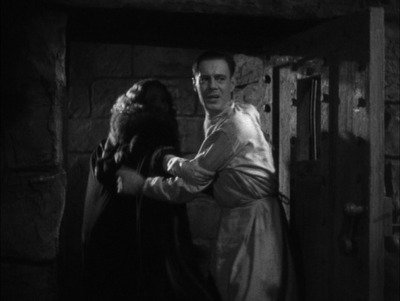
Photo credit to @colincliveforever
This look he gives before leaving is what made me love this version of Henry. Clive looks back at him with such pity and compassion that makes the ending a bittersweet tale.
Now, let me explain why Henry and Elizabeth are perhaps my favorite Universal Monster couple.
Elizabeth comes into the film determined to find out what is going on with her fiancé, asking his best friend and his professor, then not only had decided to join friend to investigate, but motivates the professor to go with them to speak to Henry. People may say she is flat, but in these scenes, we see her character; she loves Henry deeply, is on good terms with his friend, even gently putting him in his place when he suggests his romantic feelings, then will not be talked out of seeing Dr. Waldman, and convinces the men to go and see Henry. Without her, the plot may not have went forward the way it did.
Although Henry wanted no one to come in, as soon as he sees Elizabeth is there, he is willing to let them in, and tries to gently tell her to go, as he is so close to achieving his goal. Unlike perhaps some other Universal heroines, Elizabeth doesn't immediately dismiss his experiment, nor does she try to lure him away, but says she does support him, but will not leave him. Proving so, she goes into the lab and witness Henry bringing a dead body back to life, despite looking frightened at first. I love too that while Henry barks at Victor to sit down, he gently asks her to sit, "please", he adds. I love the trope of a guy getting soft around his lady love, and clearly, Elizabeth is his moral backbone.
Much what makes them work is that Colin Clive has great chemistry with both actresses who play Elizabeth, that even the jarring change from the blonde Mae Clarke to the brunette Valerie Hobson can't change that. Regardless of which actress he is playing with, Colin Clive always treats his Elizabeth with tender respect and love, making me wish I knew more about their relationship.
Hobson's Elizabeth shows off exactly what I loved about her character is how she has an inner strength, most notably in the scene where she tells off Pretorius, which makes even someone as unbothered as he is be, well, bothered by this. Even when she is kidnapped, she attempts to tell Henry where she is, and, even though we don't see it, I am headcanoning that she escaped on her own and got to the castle.
Then comes a moment that becomes one of my favorite Henry x Elizabeth scenes. At the end of Bride of Frankenstein, Elizabeth gets to Henry, desperately tries to get in the lab, unaware of the danger. Henry tells her to leave, warning her of the danger, but her response? "I won't unless you come," a line that Hobson's delivery truly sells the belief that she truly would have stayed with him.
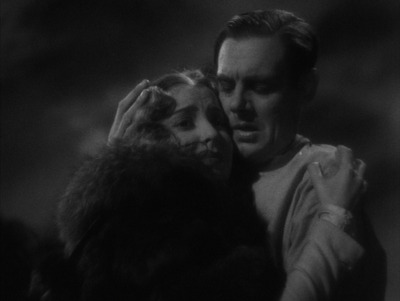
Photo credit to @colincliveforever
Among the other Universal Monster series couples, they are far from boring, far from uninteresting, and in short, I love them to bits, both separate from each other, and together.
#frankenstein 1931#bride of frankenstein#henry frankenstein#elizabeth lavenza#henry x elizabeth#colin clive#boris karloff#mae clarke#valerie hobson
11 notes
·
View notes
Text

BRIDE OF FRANKENSTEIN
Bride of Frankenstein is a 1935 American science fiction horror film, and the first sequel to Universal Pictures' 1931 film Frankenstein. As with the first film, Bride of Frankenstein was directed by James Whale starring Boris Karloff as the Monster and Colin Clive as Dr. Frankenstein. The sequel features Elsa Lanchester in the dual role of Mary Shelley and the bride. Colin Clive reprises his role as Henry Frankenstein, and Ernest Thesiger plays the role of Doctor Septimus Pretorius. Oliver Peters Heggie plays the role of the old blind hermit.
#Bride of Frankenstein#1935#movie posters#James Whale#Boris Karloff#Elsa Lanchester#Colin Clive#Ernest Thesiger#Oliver Peters Heggie
7 notes
·
View notes
Text

British actor Colin Clive

Is perhaps best known for his role as Dr. Frankenstein in the 1931 movie Frankenstein.

29 notes
·
View notes
Photo
*Rubs hands together in gleeful anticipation* Ooh, we're talking about Frankenstein side characters now are we? Here we go then...
Fritz is a very interesting character who could have a very interesting backstory. I feel like he was thrown away too quickly for us to properly get to know him, all we see in his brief scenes is a nasty little man who enjoys tormenting things he sees as beneath him. However, I see a character with potentially a lot of depth and a complex history. He is actually a very important character, as a lot does start with him; Fritz kickstarted the Monster's fear of fire, Fritz introduced the Monster to violence, by abusing the Monster, which then led to the Monster retaliating and killing Fritz. Fritz actually unleashed a chain of events that led to the rest of the story and is the main reason (I feel) as to why the Monster turned out the way he did. Despite the fact that he was given a criminal's brain, the Monster didn't seem to want to harm anyone at all at first, even though Fritz had been taunting him for a couple of days before the Monster eventually resorted to violence to get rid of Fritz. This then led to Henry agreeing to letting Waldman destroy the Monster, and so on.
My interpretation as to why Fritz was so cruel to the Monster, is because he had been treated badly his whole life because of his deformity. He loves to torment the Monster, because for once, HE is the one doing the tormenting, and it makes him feel powerful and in control. I really wish we could’ve seen him demoted to coffee boy, though, that would’ve been hilarious 😂
As for the Monster hanging Fritz, the Monster was given a “criminal brain”, and although I never got the impression that he had any memory of who the person the brain once belonged to was, it is possible that he had echoes of memories from the brain’s previous owner. The criminal might have hanged someone in the past and the Monster may have had a sort of flashback to that and knew how to tie a rope despite the fact that he, himself as an individual had not done it before. I wrote this before reading your exact same thoughts on this @hobbitmajora I’m glad I’m not the only one that thinks this!
I do sort of admire Henry for sticking up for his creation when everyone else insisted he should kill it. He certainly did a much better job than Victor Frankenstein did in the book. I think Waldman was probably fascinated by the undead Monster his former student had created, but also saw it as a threat. He seemed itching to get his hands on the Monster just so he could study him and see how Henry did it. It’s a shame he had to get choked to death, but he did kind of deserve it. I think Henry only agreed to letting Waldman destroy the Monster because he felt guilty at Fritz’s death, which brings me onto the next subject…
I don't really have any specific headcanons for Henry's history with Fritz, but I do like the idea that Henry could've just picked him up in a graveyard somewhere and probably did promise to fix his back. After that, I like to think that Fritz had some sense of loyalty to Henry, kind of like Renfield and Dracula, and decided to stick with Henry anyway. Or maybe there was some attraction there between them, and that kept Fritz loyal to Henry, and why Henry was feeling so guilty over Fritz's death even though Fritz did bring it upon himself. Or of course, they could've been old school friends, the weird kid obsessed with science and the weird kid with the hunchback. There are so many possibilities with these two!
There doesn’t seem to be any reasoning behind the Monster seeking out Elizabeth, perhaps he just stumbled upon her by accident, or, maybe he somehow knew it was the home of his creator, due to some homing instinct, like a pigeon has (ok, that’s a bit far fetched, but I couldn’t think of anything better 🤣). I also don’t think he necessarily deliberately attacked Elizabeth, as the scene goes; he climbs in through the window, Elizabeth catches sight of him and screams. Then we cut to Henry who’s looking for the Monster, we hear another scream and we find Elizabeth sprawled out on the bed, and the Monster gone. I think that the Monster followed Elizabeth with some sort of intent because it was his first encounter with a human other than Henry, Fritz and Waldman, and he was intrigued by her. Then when she screamed, the Monster left, and Elizabeth, who was already stressed out from premarital nerves and her sense of dread from the “thing that was going to happen” that she predicted before, collapsed onto the bed in fright (irritatingly cliché, I know, but then women often fainted at minor things in the movies in those days).
I feel like the film does pull you in two different directions a lot, as in one hand we’re told the Monster is a “thing of evil” because he was brought back from the dead and was accidentally given a criminal’s brain. But on the other hand, we’re supposed to believe that the Monster is just misunderstood and mistreated, as we see him play quite nicely with a little girl until he accidentally drowned her, so who knows what they were implying in the Monster/Elizabeth scene. I tend to be biased towards the Monster, as I prefer to think that he wouldn’t commit an unprovoked attack on an innocent woman who he didn’t even know. But it may have supposed to have been a deliberate assault.
I'm so sorry this was so long, I wrote this in a sort of Frankenstein-obsessed fever, as I love thinking up backstories for Frankenstein side characters! Although the Monsters are always my favourite characters, I do love to speculate on motives and reasons behind the characters’ actions, and fill in the blanks the writers/producers/directors left. I'm now determined to write some fanfiction to fill in those blanks, but who knows if I'll ever get round to it 😅
Now, if you want to talk about the Bride...

#Discussion#frankenstein discussions#Long Post#Ramble#rambles#Frankenstein Headcanons#Frankenstein Theories#Frankenstein 1931#My thoughts#Henry Frankenstein#Fritz#Dr Waldman#Elizabeth Lavenza#Elizabeth Frankenstein#Frankenstein's Monster#Frankenstein's Creation#Universal Monsters#Classic Monsters#frankenstein in the movies#1930s Movies#1930s#1931#James Whale#Jack Pierce#Dwight Frye#Colin Clive#Boris Karloff#Edward Van Sloan#Mae Clarke#Frankenstein Discussion
355 notes
·
View notes
Text
Horror Movie of the day: Frankenstein (1931) The myth of Prometeus tells the story of hubris. One, where an act of defiance to the divine order costed a man eternal punishment, for the former god changed humanity forever by giving them a gift that arose both progress and destruction, sometimes thought as a cautionary tale against arrogance in the face of discovery. But apparently Henry Frankenstein didn't get the memo, because he's just doing that: playing with life and death by trying to create human life from dead organic matter. Indeed, the reanimated corpse in front of him is a lot of things, including an impossible break through in science.
But one thing the monster isn't.. is in his control.
Directed by James Whale, this incredibly loose take on Mary Shelley's masterpiece is arguably the most iconic out of the classic Universal Monster films. The reason? It's quite grandiose. Having equally powerful vistas but a bolder cinematography than it's predecessors helps, as well as the use of sound just being that much more refined.
The adaptation of the core narrative is quite captivating as well; in spite of some drastic changes, not only does it manage to keep the central themes of the boundaries of science going awry and self destructive obsession, but the relationship between the Doctor and the Creature is engaging by being viewed from a different, less cynical but still fundamentally tragic angle. All courtesy of the performances of Colin Clive as Henry, and Boris Karloff as the creature in what would be his apotheosis in the world of horror cinema. There's a reason that makeup by Jack Pierce is to this very day THE benchmark of how a movie monster looks.
To say it is the least faithful to the source material so far would be the understatement of the century(well over half the iconic things from this movie have no precedent in the novel), but on its own terms, it certainly blew what was already a solid horror film lineup so far out of the water.

When I said this was a loose adaptation, I feel the term "loose" is on itself. Granted, it's based on a 1927 theatre play by Peggy Webling over the actual novel, but that doesn't change the fact it has created a fairly misleading image of the entire story. The way the creature looks and moves, the electricity used to create it, Dr. Frankenstein having a hunchbacked assistant, the resolution of the conflict being a massive fire, all of these things have no root in the original novel, as the way things play out have fundamental enough differences to think of this as a different story with the same starting point. One that covers many of the same themes and ideas, mind you, but what used to be a fairly slow, moody tale of mysteryand a melancholic tone gets hit with a strong sense of spectacle leading to a fairly explosive finale.
And for once... I don't think that was a bad choice. The novel is one of those stories that are enjoyed the best in written form thanks to its epistolary format, and any worthy adaptation would have to inevitably make pragmatic shifts to adequate its contents to a different medium.


And of course, I'm almost legally obligated to talk about ·the fumble".
Remember Bela Lugosi? The guy who played Dracula in the movie that came out that very same year? (...yeah, movie production didn't take entire years on average back then, go figure)
Well, he was the original candidate to play the creature, but reportedly dropped the role when he found the monster in question would only growl or vocalize without talking was beneath his acting skills. This mistake would cost him his stardom, as Boris Karloff absolutely displaced him as Universal's go to scary guy with a performance (and makeup) that just completely stole the Hungarian's thunder, not helped by the fact Karloff wasn't restricted by his accent to play more conventional and varied roles.
The rivalry between the two seems to have been exaggerated into a legendary feud, but the reality doesn't seem to suggest there was true animosity between the two, even if Lugosi would have every reason and then some to resent Karloff for displacing him into eventual mainstream obscurity at the time.

#horror movies#halloween movie#universal monsters#james whale#boris karloff#colin clive#mae clarke#john boles#dwight frye#edward van sloan#frederick kerr#frankenstein#roskirambles
5 notes
·
View notes
Text
Below are 10 articles randomly chosen from Wikipedia's Featured Articles list. Brief descriptions and links are below the cut.
Bride of Frankenstein is a 1935 American science fiction horror film, and the first sequel to Universal Pictures' 1931 film Frankenstein. As with the first film, Bride of Frankenstein was directed by James Whale starring Boris Karloff as the Monster and Colin Clive as Dr. Frankenstein. The sequel features Elsa Lanchester in the dual role of Mary Shelley and the bride.
Chew Stoke is a small village and civil parish in the affluent Chew Valley, in Somerset, England, about 8 miles (13 km) south of Bristol and 10 miles north of Wells. It is at the northern edge of the Mendip Hills, a region designated by the United Kingdom as an Area of Outstanding Natural Beauty, and is within the Bristol and Bath green belt.
David Hillhouse Buel Jr. (July 19, 1862 – May 23, 1923) was an American priest who served as the president of Georgetown University. A Catholic priest and Jesuit for much of his life, he later left the Jesuit order to marry, and subsequently left the Catholic Church to become an Episcopal priest.
Denbies is a large estate to the northwest of Dorking in Surrey, England. A farmhouse and surrounding land originally owned by John Denby was purchased in 1734 by Jonathan Tyers, the proprietor of Vauxhall Gardens in London, and converted into a weekend retreat. The house he built appears to have been of little architectural significance, but the Gothic garden he developed in the grounds on the theme of death achieved some notoriety, despite being short-lived.
Courbet was the lead ship of her class of four dreadnought battleships, the first ones built for the French Navy. She was completed shortly before the start of World War I in August 1914.
The ketogenic diet is a high-fat, adequate-protein, low-carbohydrate dietary therapy that in conventional medicine is used mainly to treat hard-to-control (refractory) epilepsy in children. The diet forces the body to burn fats rather than carbohydrates.
The football match between Manchester United and Ipswich Town played at Old Trafford, Manchester, on 4 March 1995 as part of the 1994–95 FA Premier League finished in a 9–0 victory for the home team. The result stands as the joint record, with Southampton having subsequently lost by the same scoreline at home to Leicester City in 2019 and away at Manchester United in 2021, while Bournemouth also lost 9–0 to Liverpool in 2022.
M-185 is a state trunkline highway in the U.S. state of Michigan that circles Mackinac Island, a popular tourist destination on the Lake Huron side of the Straits of Mackinac, along the island's shoreline. A narrow paved road of 8.004 miles (12.881 km), it offers scenic views of the straits that divide the Upper and the Lower peninsulas of Michigan and Lakes Huron and Michigan.
Santa María de Óvila is a former Cistercian monastery built in Spain beginning in 1181 on the Tagus River near Trillo, Guadalajara, about 90 miles (140 km) northeast of Madrid. During prosperous times over the next four centuries, construction projects expanded and improved the small monastery. Its fortunes declined significantly in the 18th century, and in 1835 it was confiscated by the Spanish government and sold to private owners who used its buildings to shelter farm animals.
Sarcoscypha coccinea, commonly known as the scarlet elf cup, or the scarlet cup, is a species of fungus in the family Sarcoscyphaceae of the order Pezizales. The fungus, widely distributed in the Northern Hemisphere, has been found in Africa, Asia, Europe, North and South America, and Australia.
9 notes
·
View notes
Note
Combs doesn’t get paid enough for the bs he puts up with.
Dr Combs just wanted to do some direct research instead of everybody's labwork. He signed up to research 049. He didn't know what he was getting himself into.

Trivia about Combs - while Victoria West is named for Victor Frankenstein and Herbert West, Colin Combs is named for Colin Clive and Jeffrey Combs, the actors who originally played Frankenstein and West. So West is named for fictional characters and Combs is named for humans. West grew up sheltered in a suburb and her entire adult life has been working for the Foundation, Combs spent his life in the real world ( well, the 'real world' of the SCPverse ) and joined the Foundation when he was older - metawise, the names are a hint that Combs is more human and grounded than West, who never had much contact with the real world.
17 notes
·
View notes
Text
Sci-Fi Saturday: Frankenstein
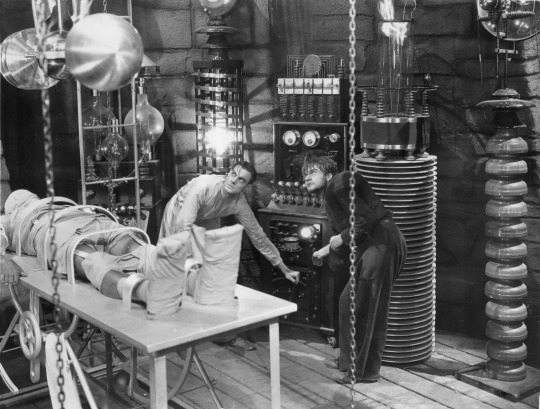
Week 7:
Film(s): Frankenstein (Dir. James Whale, 1931, USA)
Viewing Format: DVD
Date Watched: June 25, 2021
Rationale for Inclusion:
Science fiction is like a reality of sexual reproduction: while the father may not be readily known, the mother is always evident. Before any of the men competing for the title "Father of Science Fiction '' were born, Mary Shelley had lived, died, and in between wrote one of the most influential works of Western literature: Frankenstein; Or, the Modern Prometheus. Born a Gothic horror novel, it is now recognized as the first true science fiction story.
Like other popular novels of its era, Frankenstein was adapted first as plays and later as a one reel motion picture by the Edison company in 1910. However, the work's lasting legacy in popular culture and the public imagination would not become firmly established until 1931 when Boris Karloff shambled on screen in James Whale's Frankenstein.
Wanting to further cash in on the public's interest in adaptations of literary horror, Universal Studios green-lit Frankenstein after the record breaking success of Dracula (Dir. Todd Browning, 1931, USA). Originally slated to be a Bela Lugosi vehicle directed by the established Robert Florey, the project ended up under the direction of up and comer James Whale, who cast Karloff, a bit-player with 81 film credits to his name, as the Monster.
The film was a commercial and critical success in 1931. It spawned imitators, more literary horror adaptations, sequels, spoofs, and a host of pop culture references. In fact, when you hear the word "Frankenstein" you likely pictured Karloff as the Monster: green skinned, square headed and sporting neck bolts.
Reactions:
For all its cultural influence, Frankenstein is not a faithful adaptation of Shelley's original novel. The script was adapted from a stage play adaptation of the novel by Peggy Webling, and along the way the novel's setting was updated to the present day and most key elements were greatly changed or discarded. Yet, the most profound difference between Whale's film and the novel is that the Monster is an inarticulate golem with a "criminal" brain, instead of an intelligent, articulate creature of horrible visage.
Given the influence of silent horror cinema on Universal's cycle of 1930s horror films, it follows that the criminal brain plot element was likely inspired by the foundational body horror film The Hands of Orlac (Dir. Robert Wiene, 1924, Austria), in which a concert pianist believes the hand transplant he received also included inheriting the donor's criminal tendencies. I am uncertain if the bad brain justifying why the creature was considered flawed and/or was prone to rampage originated in the Webling play, or in drafts of the screenplay when Florey was in charge of Frankenstein. At any rate, it was under Whale that the sympathy and innocence of the Creature in the novel was semi-restored.
In fact, for all the concern expressed by Henry Frankenstein's (Colin Clive) former teacher Dr. Waldman (Edward Van Sloan) about the criminal brain, as the story progresses it becomes clear to the audience that his brain is not the reason for violent acts committed by the Monster. Two of the three murders that the Monster commits over the course of the film are in self defense. The third, the infamous drowning of the little girl, is a terrible accident. Despite taking a different path to get there, Frankenstein still arrives at a core aspect of Shelley's original novel: the Creature is not inherently monstrous, but becomes so in response to the abuse and mistreatment he receives because of his grotesque appearance.
The concept of evil brains and a person's badness carrying over to transplanted pieces of their body persists in horror sci-fi. As previously noted, Frankenstein did not originate this trope, but it aided in popularizing it.
One thing Whale's film did originate is the common process by which the Monster comes to life. In Shelley's novel, the exact method of how Victor Frankenstein animates his creation is kept intentionally vague (so that the experiment cannot be repeated), though it is implied via a notable episode in his childhood that lightning, or rather electricity, plays a role.
Harnessing electricity via spectacular laboratory equipment had previously been introduced in cinema via the set-up for giving the Maschinenmensch the likeness of Maria in Metropolis (Dir. Fritz Lang, 1927, Germany). Likely inspired by that sequence as well as Kenneth Strickfaden's work on the recently released Just Imagine (Dir. David Butler, 1930, USA), Whale hired Strickfaden to design Dr. Frankenstein's lab. Building off of what he had created for Just Imagine, Strickfaden created additional machinery, including a colossal Tesla coil, to give the impression of advanced, experimental technology at work. Even for people who have not seen Whale's Frankenstein, machinery with dials and meters and a sparking Tesla coil have come to define the stereotypical aesthetic of a mad scientist's lab, along with the crash of thunder, flash of lightning and screams of "it's alive!"
Yet, the Monster is frequently inaccurately referred to as "Frankenstein" for a reason: he more than his creator is the main attraction. Of all the essential contributors to Frankenstein I would be remiss if I closed out this post without discussing the marriage of Jack Pierce's effects make-up with Karloff's performance. It took four hours of Pierce building up cotton, collodion and gum, then applying a green greasepaint that would render Karloff's skin tone pale on the black and white film stock, to get the actor into character. Despite the primitive yet bespoke process, the final result did not inhibit Karloff's ability to deliver a performance that ranges from stoic to delighted to panicked, and allowed for nuanced as well as broad facial expressions. Pierce and Karloff's combined work remains a benchmark of artistic collaboration.
It seems hyperbolic to call Frankenstein a perfect film, but movies like it, where a blend of outstanding collaborators and serendipity produce something enduring and iconic, are rare. Whale's Frankenstein also represents, at least on this survey, the first time an adaptation innovated beyond its source material to become influential and noteworthy in its own right. I am not sure we will encounter another film where that is true until we get around to Blade Runner (Dir. Ridley Scott, 1982, USA).
2 notes
·
View notes